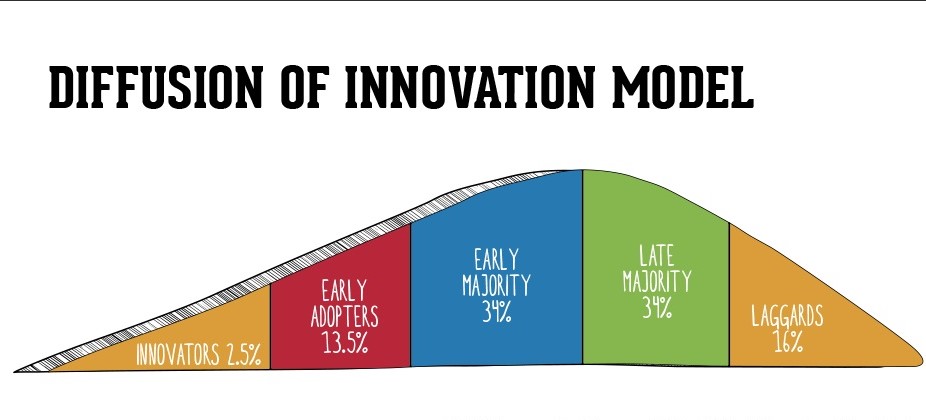“Innovation distinguishes between a leader and a follower”, Steve Jobs said. Innovation behavior has positive relationships with career progression (salary growth and the number of promotions) and career satisfaction.
Only a few people are really innovators. According to Everett Rogers, 2.5% of the population. The professor got to this conclusion in the book Diffusion of Innovations, in which he explains his theory on how, why and at what rate new ideas and technology spread. He divided the technology adoption life cycle in 5 stages, by profiles of people that prevails in each stage.
Innovators are willing to take risks, have the highest social status, have financial liquidity, are social and have closest contact to scientific sources and interaction with other innovators. Their risk tolerance allows them to adopt technologies that may ultimately fail. Financial resources help absorb these failures.
Close to them are the “early adopters” of new technologies, about 13,5% of people. These individuals are also usually seen as “innovators” and have the highest degree of opinion leadership among the adopter categories. Early adopters have a higher social status, financial liquidity, advanced education and are more socially forward than late adopters. They are more discreet in adoption choices than innovators. They use judicious choice of adoption to help them maintain a central communication position.
Following them are the “early majority”, with 34%. They adopt an innovation after a varying degree of time that is significantly longer than the innovators and early adopters. Early Majority have above average social status, contact with early adopters and seldom hold positions of opinion leadership in a system.
Nobody is an innovator or a laggard for everything.
Each behavior depends on what is at stake
In the fourth stage come the “late majority”, also about 34% of population. They adopt an innovation after the average participant. These individuals approach an innovation with a high degree of skepticism and after the majority of society has adopted the innovation. Late Majority are typically skeptical about an innovation, have below average social status, little financial liquidity, in contact with others in late majority and early majority and little opinion leadership.
At last, with the same amount of people of innovators and early adopters together, 16%, are the “laggards”. Unlike some of the previous categories, individuals in this category show little to no opinion leadership. These individuals typically have an aversion to change-agents. Laggards typically tend to be focused on “traditions”, lowest social status, lowest financial liquidity, oldest among adopters, and in contact with only family and close friends.
Nobody is an innovator or a laggard for everything. Each behavior depends on what is at stake. The closer you get to innovator behaviors, the more you resemble a leader. On the other hand, the more you distance yourself, the longer you will must follow other people.
For more on adapting technology in business, visit our blog




